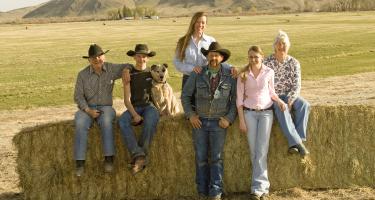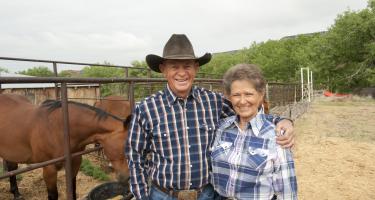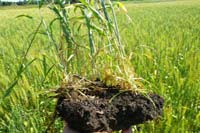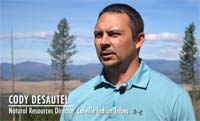Browse our Growing Library of Success Stories
By:
Family Farm AllianceThis multi-generation family takes care of their livestock and ranch in a way that prioritizes the health of the land. They actively participate in conservation efforts and land stewardship programs, including conservation easements and river bank restoration projects in partnership with Fish and Wildlife. Preserving the integrity of their ranch and managing it responsibly is of utmost importance to them, and they have put considerable effort into estate planning to ensure its continued success.
By:
Sage Grouse Initiative Research from an eight-year study in the Warner Mountains shows why strategically removing encroaching trees spells good news for sage grouse, a declining upland bird that serves as a benchmark for the overall health of the sagebrush biome. Researchers quantified a six-fold increase in sage grouse’s preferred habitat following woodland management and a population growth rate that was +12 percent higher in the treated area than in the control area without management.
Research from an eight-year study in the Warner Mountains shows why strategically removing encroaching trees spells good news for sage grouse, a declining upland bird that serves as a benchmark for the overall health of the sagebrush biome. Researchers quantified a six-fold increase in sage grouse’s preferred habitat following woodland management and a population growth rate that was +12 percent higher in the treated area than in the control area without management.
This adds to a growing list of research — much of it based on the long-term study in the Warners — that documents the myriad benefits of conifer removal for wildlife and grazing lands.
By:
Leopold Conservation Award Program For Colby and McKenzie Pace, raising beef cattle includes keeping a sharp eye on preventing overgrazing and noxious weeds and seeking out ways to improve their land for nesting and migrating shorebirds. This forward-thinking approach to livestock and wildlife management earned the Coalville couple — and their Half Circle Cross Ranch — the 2020 Utah Leopold Conservation Award.
For Colby and McKenzie Pace, raising beef cattle includes keeping a sharp eye on preventing overgrazing and noxious weeds and seeking out ways to improve their land for nesting and migrating shorebirds. This forward-thinking approach to livestock and wildlife management earned the Coalville couple — and their Half Circle Cross Ranch — the 2020 Utah Leopold Conservation Award.
By:
Leopold Conservation Award Program Beatty Canyon Ranch shines at doing right by the land, water, livestock and wildlife amid the grandeur of southeastern Colorado’s canyon landscape.
Beatty Canyon Ranch shines at doing right by the land, water, livestock and wildlife amid the grandeur of southeastern Colorado’s canyon landscape.
By:
Leopold Conservation Award Program Dick Tanner grew up on the Bohart Ranch after his father, Jim Tanner began managing it for Field Bohart in 1942. After attending college and spending several years in agricultural finance in Denver, he and his wife, Sandra, decided to return to the ranch. Today, the Tanner family ranches 48,000 acres of State Land Board land year Yoder, Colorado in addition to acreage that has been in Sandra's family for more tnan 50 years. The family runs a 700-1,200 head cow-calf operation, depending on range conditions.
Dick Tanner grew up on the Bohart Ranch after his father, Jim Tanner began managing it for Field Bohart in 1942. After attending college and spending several years in agricultural finance in Denver, he and his wife, Sandra, decided to return to the ranch. Today, the Tanner family ranches 48,000 acres of State Land Board land year Yoder, Colorado in addition to acreage that has been in Sandra's family for more tnan 50 years. The family runs a 700-1,200 head cow-calf operation, depending on range conditions.
By:
Leopold Conservation Award Program The fifth-generation Coleman Ranch consists of irrigated meadows and mixed short- and tallgrass prairie in Saguache, located approximately 200 miles southwest of Denver. The ranch, owned and operated by Jim and Frances Coleman, their son, Tim, and his wife, Teddi, has raised certifed natural organic beef under the Coleman Natural brand for almost 30 years.
The fifth-generation Coleman Ranch consists of irrigated meadows and mixed short- and tallgrass prairie in Saguache, located approximately 200 miles southwest of Denver. The ranch, owned and operated by Jim and Frances Coleman, their son, Tim, and his wife, Teddi, has raised certifed natural organic beef under the Coleman Natural brand for almost 30 years.
By:
Leopold Conservation Award Program For over 100 years, the Johnson family’s philosophy has been to leave resources under their stewardship in better condition than when they found them, and to pass their ranch on to the next generation. Located near Kit Carson, Flying Diamond Ranch is now in its fifth generation and the family is determined to pass it on to the sixth.
For over 100 years, the Johnson family’s philosophy has been to leave resources under their stewardship in better condition than when they found them, and to pass their ranch on to the next generation. Located near Kit Carson, Flying Diamond Ranch is now in its fifth generation and the family is determined to pass it on to the sixth.
By:
Leopold Conservation Award Program John and Carolyn Doherty’s 32,000-acre ranch in Las Animas County is the product of five generations of outstanding land management. John’s grandfather, “Papa Joe,” understood the importance of conservation, especially water management, to a ranching operation. His approach was passed down to John’s parents, Joe and “Tiny.”
John and Carolyn Doherty’s 32,000-acre ranch in Las Animas County is the product of five generations of outstanding land management. John’s grandfather, “Papa Joe,” understood the importance of conservation, especially water management, to a ranching operation. His approach was passed down to John’s parents, Joe and “Tiny.”
By:
Leopold Conservation Award Program Siblings Jo Ann McEndree, Kaye Kasza, Steve McEndree and Cathy Tebay are fourth generation ranchers who are highly committed to the economic and environmental health of their Pipe Springs Ranch, located near Springfield, so it can be passed on to future generations.
Siblings Jo Ann McEndree, Kaye Kasza, Steve McEndree and Cathy Tebay are fourth generation ranchers who are highly committed to the economic and environmental health of their Pipe Springs Ranch, located near Springfield, so it can be passed on to future generations.
By:
Leopold Conservation Award Program Located southwest of Fowler, Rancho Largo Cattle Company is a 14,000-acre cow/calf and stocker cattle ranch managed by Grady, and co-owned with his former college roommate Robert Lovelace. Depending on weather and grass availability, Grady adjusts his numbers of cows, calves and stocker cattle through buying and selling, making him less dependent on one section of the industry.
Located southwest of Fowler, Rancho Largo Cattle Company is a 14,000-acre cow/calf and stocker cattle ranch managed by Grady, and co-owned with his former college roommate Robert Lovelace. Depending on weather and grass availability, Grady adjusts his numbers of cows, calves and stocker cattle through buying and selling, making him less dependent on one section of the industry.
By:
Leopold Conservation Award Program The San Isabel Ranch, located in Westcliffe, Colorado has a 135 year history of agriculture. The success of the ranch can largely be attributed to the late Dr. Ben Kettle and his wife, Bet. The operation is now run by the Kettles’ daughter, Sara Shields, and her husband, Mike, but Bet is still very much involved.
The San Isabel Ranch, located in Westcliffe, Colorado has a 135 year history of agriculture. The success of the ranch can largely be attributed to the late Dr. Ben Kettle and his wife, Bet. The operation is now run by the Kettles’ daughter, Sara Shields, and her husband, Mike, but Bet is still very much involved.
By:
Leopold Conservation Award Program The Tureceks have ranched and farmed on the eastern plains of Colorado since 1910. Over the last 36 years, Keven and Sandi Turecek have combined land from both sides of the family to create what is now the Stacked Lazy 3 Ranch, a cow/calf and dryland wheat business comprised of 5,000 acres of farmland and 30,000 acres of pasture.
The Tureceks have ranched and farmed on the eastern plains of Colorado since 1910. Over the last 36 years, Keven and Sandi Turecek have combined land from both sides of the family to create what is now the Stacked Lazy 3 Ranch, a cow/calf and dryland wheat business comprised of 5,000 acres of farmland and 30,000 acres of pasture.
By:
Leopold Conservation Award Program Jim and Jo Stanko’s ranch, near Steamboat Springs, has been in the family since 1907. Their love for their land is evident in that Jim cites the ranch’s centennial anniversary as one of the greatest accomplishments of his life.
Jim and Jo Stanko’s ranch, near Steamboat Springs, has been in the family since 1907. Their love for their land is evident in that Jim cites the ranch’s centennial anniversary as one of the greatest accomplishments of his life.
By:
Leopold Conservation Award Program Turkey Creek Ranch, sandwiched between the U.S. Army’s Fort Carson and the growing urban community of Pueblo West, is owned and operated by Gary and Georgia Walker, and consists of approximately 65,000 deeded acres managed for both wildlife and livestock.
Turkey Creek Ranch, sandwiched between the U.S. Army’s Fort Carson and the growing urban community of Pueblo West, is owned and operated by Gary and Georgia Walker, and consists of approximately 65,000 deeded acres managed for both wildlife and livestock.
By:
Leopold Conservation Award Program A deep passion for the land entrusted to them, and a willingness to embrace and adapt to change, has kept the Visintainers at the forefront of innovative ranch management.
A deep passion for the land entrusted to them, and a willingness to embrace and adapt to change, has kept the Visintainers at the forefront of innovative ranch management.
By:
Leopold Conservation Award Program Russell and Tricia Davis’ Wineinger-Davis Ranch, located in Lincoln and Crowley Counties, was established in 1938 as a 400 acre livestock operation. It currently consists of over 12,000 acres. Ranch operations include beef production, birding, ecotourism, agri-tourism, and hunting.
Russell and Tricia Davis’ Wineinger-Davis Ranch, located in Lincoln and Crowley Counties, was established in 1938 as a 400 acre livestock operation. It currently consists of over 12,000 acres. Ranch operations include beef production, birding, ecotourism, agri-tourism, and hunting.
By:
K. Gregg Elliott The nonprofit Soil Health Academy (SHA) is just one of many initiatives spawned by regenerative agriculture guru Gabe Brown in collaboration with additional expert partners. SHA holds regenerative agriculture workshops around the country that are open to anyone who’s interested, and they are routinely sold out.
The nonprofit Soil Health Academy (SHA) is just one of many initiatives spawned by regenerative agriculture guru Gabe Brown in collaboration with additional expert partners. SHA holds regenerative agriculture workshops around the country that are open to anyone who’s interested, and they are routinely sold out.
By:
Gregg Elliott When Heather Dutton, fresh out of undergraduate school at the Warner College of Natural Resources and graduate school in the College of Agriculture at Colorado State University, began her first job working for a non-profit river restoration organization in the San Luis Valley, she was thrilled. She also felt confident that her technical training in restoration ecology had prepared her for the challenges she’d soon be facing.
When Heather Dutton, fresh out of undergraduate school at the Warner College of Natural Resources and graduate school in the College of Agriculture at Colorado State University, began her first job working for a non-profit river restoration organization in the San Luis Valley, she was thrilled. She also felt confident that her technical training in restoration ecology had prepared her for the challenges she’d soon be facing.
Heather was in for a surprise.
By:
Natural Resources Conservation Service This video is the story of a young scientist, Hugh Hammond Bennett, who recognized 80 years ago that the United States was at risk of losing it’s most important resource – its soil. He made it his mission to change the trajectory of agriculture at a time of great crisis and to provide farmers and ranchers with the information and tools they needed to be sustainable.
This video is the story of a young scientist, Hugh Hammond Bennett, who recognized 80 years ago that the United States was at risk of losing it’s most important resource – its soil. He made it his mission to change the trajectory of agriculture at a time of great crisis and to provide farmers and ranchers with the information and tools they needed to be sustainable.
This 21 minute video is the story of the conservation movement that Hugh Hammond Bennett began and includes interesting insights into the policies and structures that he set up that we continue to rely on today. His work revealed so much of what we’re rediscovering and renaming as “regenerative agriculture.”
By:
Washington Policy Center This video from Washington Policy Center with cooperation from the Confederated Tribes of the Colville Reservation, sheds light on how the tribes manage forests to be more healthy using commercial harvests, thinnings, and controlled burns to deal with the pressures of insect infestation, climate change, and decades of fire suppression.
This video from Washington Policy Center with cooperation from the Confederated Tribes of the Colville Reservation, sheds light on how the tribes manage forests to be more healthy using commercial harvests, thinnings, and controlled burns to deal with the pressures of insect infestation, climate change, and decades of fire suppression.